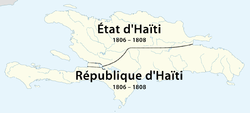State of Haiti
| State of Haiti | ||||||||||
| État d'Haïti Leta an Ayiti | ||||||||||
| ||||||||||
 The State of Haiti in the north of Hispaniola, with the . | ||||||||||
| Capital | Milot | |||||||||
| Languages | French, Haitian Creole | |||||||||
| Religion | Roman Catholic | |||||||||
| Government | Republic | |||||||||
| President | ||||||||||
| • | 1806–1811 | Henri Christophe | ||||||||
| History | ||||||||||
| • | Established | 17 October 1806 | ||||||||
| • | Disestablished | 28 March 1811 | ||||||||
| Currency | Haitian livre | |||||||||
| ||||||||||
The State of Haiti (French: État d'Haïti, Haitian Creole: Leta an Ayiti) was the name of the state in northern Haiti. It was created on October 17, 1806 following the overthrow of the Empire of Haiti following the assassination of Emperor Jacques I. The northern State of Haiti was ruled by Henri Christophe originally as Provisional Chief of the Haitian Government from October 17, 1806 until February 17, 1807 when he became President of the State of Haiti. The 1807 constitution for the State of Haiti made the post of president a position for life with the president having the power to appoint his successor. On March 28, 1811 President Henri was proclaimed King Henry I, thereby dissolving the State of Haiti and creating the Kingdom of Haiti.
In 1806 Alexandre Pétion became the president of the southern Republic of Haiti and ruled for several years. He was succeeded by Jean-Pierre Boyer, who reunited the two parts of the nation after the deaths of Henry I and his son in 1820.
